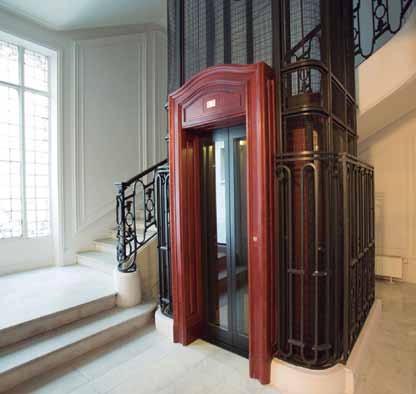
Accessibility, comfort… Whether for offices, medical practices or even private accommodation, the elevator has become essential equipment for buildings, both old and new. And even if almost all existing buildings can be retrofitted, installing elevators is sometimes a technical challenge, especially in Haussmannian buildings. Therefore, equipping the latter with elevators requires finding the right balance between conservation and modernization.
In 1852 Napoleon III commissioned Georges-Eugène Haussmann, a civil servant in his government, to “modernize” Paris. By hiring Haussmann, he was confident that Paris could become a city with safer streets, better houses, healthier, hospitable communities that would facilitate shopping and also achieve greater fluidity in traffic. Until then, Paris and other cities in Europe were covered in mud and makeshift shacks, damp and fetid, full of poverty, as well as traces of garbage and waste in the streets left by faulty and inadequate sewerage.
Haussmann removed many old, winding streets and pulled down apartment houses. He replaced them with avenues, wide avenues lined with trees, and created extensive gardens for which Paris is famous today. Haussmann’s plan also included a uniform height of buildings and landmarks such as the Arc de Triomphe and the Grand Opera House.
The typical Paris that we can see today with similar buildings and window balconies with iron bars dates back to that time. And they call those classic buildings Haussmann buildings.
Haussmannian buildings: a diversity of uses?
Today, Haussmann’s buildings represent 60% of Parisian buildings (that is, just over 57,000 buildings) and are essentially residential, although this type of building often also includes the office of a lawyer, a notary, a trustee, a lawyer, or doctors, or even a communications company or a journalist’s office. These 19th-century buildings offer many advantages: an often central location, an environment perceived as prestigious…
It should be noted, however, that with the new regulations, particularly environmental regulations, which apply to tertiary use premises, this diversity of uses could well be reduced. The energy rehabilitations required, for example, by the tertiary decree, encourage certain companies to sell their Haussmann-style offices to settle in more recent premises – even if it means moving – so as not to have to invest in costly reforms.
The elevator: an evaluation index
But whether it is intended for individuals or professionals, the elevator has become a key piece of equipment and a real estate valuation tool. For Éric Koely, commercial director of ATS -a subsidiary of KONE specializing in equipment for old buildings- “the costs incurred by the owners for the installation of an elevator are largely amortized by the increase in the price of the apartments”.
If already 60% of Parisian Haussmann buildings are equipped with elevators, according to Éric Koely, the park’s equipment rate varies enormously from one district to another. The commercial director of ATS specifies that most of the Haussmann buildings with elevators are located in “upscale” neighborhoods such as the 16th, 8th, and 7th districts. And the increased attractiveness of certain districts such as the 11th district, or certain towns in the inner periphery such as Levallois-Perret, Clichy, or Montrouge, directly affects the level of demand for the installation of a lift. The latter has become a prerequisite for these new inhabitants who want a certain level of comfort and service.
Installing an elevator in a Haussmannian building: a technical challenge
But if equipping Haussmann buildings with an elevator has become common practice, this does not stop posing two great challenges:
Find enough space to accommodate the elevator shaft, in a space not designed to accommodate it;
Do not distort the building, especially if it has heritage value.
“When a new building is created, the architect has planned a location for the elevator shaft and a room for the machinery. Haussmannian buildings, on the other hand, were not designed for this purpose. Fortunately, these are buildings that in most cases have basements or lower parts, which can be transformed into machine rooms. Otherwise, entrust the trustee to recover a place that allows the premises to be installed there or the elevator operator to install an elevator with the motor in the shaft”, explains Éric Koely.
Source: www.kone.fr




